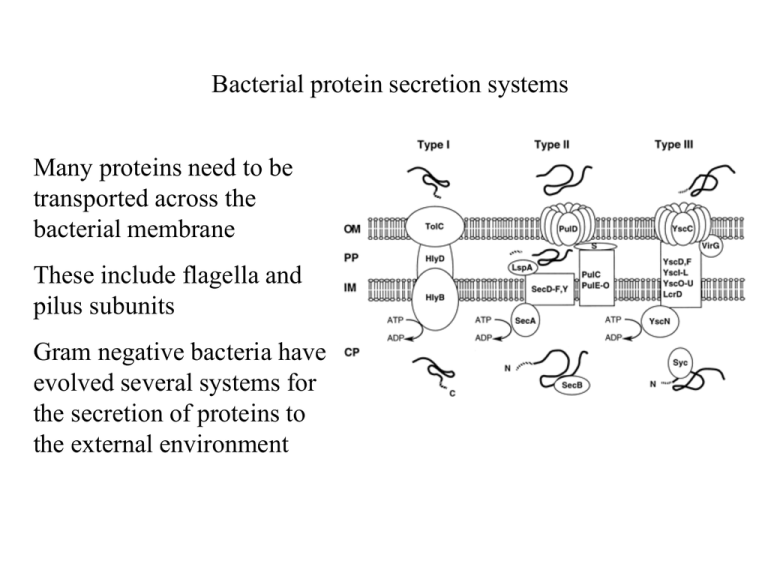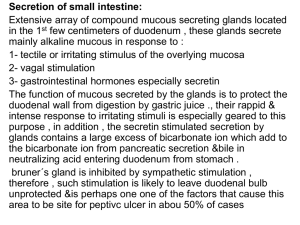9/14
advertisement

Bacterial protein secretion systems Many proteins need to be transported across the bacterial membrane These include flagella and pilus subunits Gram negative bacteria have evolved several systems for the secretion of proteins to the external environment Bacterial protein secretion systems Different systems are named according to the order in which they were discovered i.e. Type I, II, III, IV, etc. Gram negative protein secretion systems Gram negative protein secretion systems Sec-dependent pathway Also known as the general secretory pathway (GSP) Most commonly used system to transport proteins across plasma membrane or integrate them into the membrane Used by both gram positive and gram negative bacteria Sec-dependent pathway System composed of both cytosolic and membranebound proteins Secreted proteins contain Nterminal signal sequence Chaperone protein binds to sequence and guides protein to transport machinery or translocon Sec-dependent pathway Chaperones include SecB and signal recognition particle (SRP) Chaperones release preprotein which binds to SecA Sec-dependent pathway SecA translocates preprotein through SecYEG complex Hydrolysis of ATP drives translocation After emerging from the membrane, signal peptide is removed by signal peptidase Type II secretion systems Found in many gramnegative bacteria, including species of Erwinia, Pseudomonas and Vibrio Used for the secretion of proteins through the outer membrane Composed of as many as 14 different proteins (both inner and outer membrane-localized) Type II secretion systems Outer membrane protein forms a channel through which protein can pass Family of proteins referred to as secretins Secretins Type I secretion systems Also known as ABC protein secretion pathway ABC = ATP-binding cassette Secretion is independent of the sec pathway Type I secretion systems Used for the secretion of various enzymes and toxins including -hemolysin Secreted proteins contain a C-terminal (noncleavable) signal sequence Type I secretion systems Are composed of only three different proteins 1. ATP -binding inner membrane protein 2. Outer membrane channel-forming protein 3. Membrane fusion protein Type I secretion systems Type I secretion systems Proteins transported across both membranes in a single step Energy for translocation derived from hydrolysis of ATP Type III secretion systems Found in a number of gramnegative bacteria Bacteria with TTSS always exhibit intimate contact with host cells Systems designed to both secrete and translocate or “inject” proteins into host cells Type III secretion systems Composed of at least 20 different proteins Include cytosolic, membrane-bound and secreted proteins Membrane proteins form a structure similar to the flagella basal body named the needle complex Type III secretion systems Outer membrane component of needle complex belongs to the secretin family of proteins Proteins transported across both membranes in a single step Hydrolysis of ATP provides energy for translocation Type III secretion systems Type III secretion systems Type III secretion systems Type III secretion systems Many protein required for secretion through needle complex are similar to flagella assembly proteins TTSSs likely evolved from bacterial flagella systems Type IV secretion systems Can be used to transfer proteins or DNA from one cell to another Transfer proteins to eukaryotic host cells Transfer plasmids to bacterial cells (conjugation) Type IV secretion systems Composed of several proteins that span the entire cell wall Hydrolysis of ATP provides energy for transport Found in many bacterial pathogens including species of Legionella, Bordetella and Helicobacter Conjugal pilus Several morphologically distinct pili Appear to function as adhesins rather than transfer conduits Retraction of pilus pulls cells close together Type IV secretion/ autotransporters Transport through inner membrane is sec-dependant All substrates carry secsignal sequence Proteins divided into three domains i) sec signal sequence, ii) passenger domain, iii) -barrel domain Type IV secretion/ autotransporters Type IV secretion/ autotransporters OM ATP Sec Y E G SecA ADP Sec Y E G IM N SecB C Gram negative protein secretion systems











